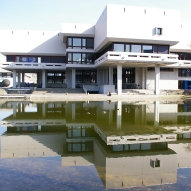 ; Monaghan, Euan P. ; Riedo, Andreas ; Ehrenfreund, Pascale ; Garcia-Descalzo, Laura
; Monaghan, Euan P. ; Riedo, Andreas ; Ehrenfreund, Pascale ; Garcia-Descalzo, Laura  ; Gómez, Felipe
; Gómez, Felipe  ; Malki, Moustafa ; Amils, Ricardo ; Gaboyer, Frédéric ; Hickman-Lewis, Keyron ; Westall, Frances ; Cabezas, Patricia
; Malki, Moustafa ; Amils, Ricardo ; Gaboyer, Frédéric ; Hickman-Lewis, Keyron ; Westall, Frances ; Cabezas, Patricia  ; Walter, Nicolas ; Rettberg, Petra
; Walter, Nicolas ; Rettberg, Petra 
| Dokumentenart: | Artikel | ||||
|---|---|---|---|---|---|
| Titel eines Journals oder einer Zeitschrift: | Current Issues in Molecular Biology | ||||
| Verlag: | CAISTER ACAD PRESS | ||||
| Ort der Veröffentlichung: | POOLE | ||||
| Seitenbereich: | S. 103-122 | ||||
| Datum: | 2020 | ||||
| Institutionen: | Biologie und Vorklinische Medizin > Institut für Biochemie, Genetik und Mikrobiologie > Lehrstuhl für Mikrobiologie (Archaeenzentrum) | ||||
| Identifikationsnummer: |
| ||||
| Stichwörter / Keywords: | WATER ACTIVITY; LIQUID WATER; GALE CRATER; PERCHLORATE; HABITABILITY; SURVIVAL; SALTS; LIFE; TOLERANCE; RADIATION; | ||||
| Dewey-Dezimal-Klassifikation: | 500 Naturwissenschaften und Mathematik > 570 Biowissenschaften, Biologie | ||||
| Status: | Veröffentlicht | ||||
| Begutachtet: | Ja, diese Version wurde begutachtet | ||||
| An der Universität Regensburg entstanden: | Ja | ||||
| Dokumenten-ID: | 50520 |
 Web of Science
Web of ScienceZusammenfassung
Five bacterial (facultatively) anaerobic strains, namely Buttiauxella sp. MASE-IM-9, Clostridium sp. MASE-IM-4, Halanaerobium sp. MASE-BB-1, Trichococcus sp. MASE-IM-5, and Yersinia intermedia MASE-LG-1 isolated from different extreme natural environments were subjected to Mars relevant environmental stress factors in the laboratory under controlled conditions. These stress factors encompassed ...

Zusammenfassung
Five bacterial (facultatively) anaerobic strains, namely Buttiauxella sp. MASE-IM-9, Clostridium sp. MASE-IM-4, Halanaerobium sp. MASE-BB-1, Trichococcus sp. MASE-IM-5, and Yersinia intermedia MASE-LG-1 isolated from different extreme natural environments were subjected to Mars relevant environmental stress factors in the laboratory under controlled conditions. These stress factors encompassed low water activity, oxidizing compounds, and ionizing radiation. Stress tests were performed under permanently anoxic conditions. The survival rate after addition of sodium perchlorate (Na-perchlorate) was found to be species-specific. The inter-comparison of the five microorganisms revealed that Clostridium sp. MASE-IM-4 was the most sensitive strain (D-10-value (15 min, NaClO4) = 0.6 M). The most tolerant microorganism was Trichococcus sp. MASE-IM-5 with a calculated D-10-value (15 min, NaClO4) of 1.9 M. Cultivation in the presence of Na-perchlorate in Martian relevant concentrations up to 1 wt% led to the observation of chains of cells in all strains. Exposure to Na-perchlorate led to a lowering of the survival rate after desiccation. Consecutive exposure to desiccating conditions and ionizing radiation led to additive effects. Moreover, in a desiccated state, an enhanced radiation tolerance could be observed for the strains Clostridium sp. MASE-IM-4 and Trichococcus sp. MASE-IM-5. These data show that anaerobic micro-organisms from Mars analogue environments can resist a variety of Martian-simulated stresses either individually or in combination. However, responses were species-specific and some Mars-simulated extremes killed certain organisms. Thus, although Martian stresses would be expected to act differentially on microorganisms, none of the expected extremes tested here and found on Mars prevent the growth of anaerobic microorganisms.
Metadaten zuletzt geändert: 11 Okt 2021 13:06



 Altmetric
Altmetric